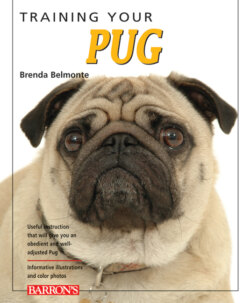Читать книгу Training Your Pug - Brenda Belmonte - Страница 12
На сайте Литреса книга снята с продажи.
You and Your Pug
ОглавлениеHaving a Pug as your companion can be a constant source of joy, bringing a smile to your face each time he greets you at the door. But when a Pug is improperly socialized, poorly trained, or living as an independent entity within a family, the relationship changes and living with him can be a challenge. Establishing the ability to effectively communicate with your Pug should be one goal every member of the family tries to achieve from the very moment the Pug joins the family.
Pugs were bred to be companions. They are most comfortable when they have a consistent role within a family and can count on endless hours of physical interaction with family members. A Pug’s ability to fit in with his human family can be dependent on a variety of factors, including
∎ social skills that a Pug has learned by interacting with littermates and adult dogs;
∎ the ability of the human family to communicate using body language and vocal patterns that the Pug already understands;
∎ the ability of the human family to recognize behaviors that are good;
∎ properly timed rewards given to the Pug for good behaviors;
∎ and proper managment of the Pug’s environment to limit his ability to learn bad behaviors.
Bonding
The relationship between a Pug and his owner is often referred to as the “bond” between them. Pugs develop a strong bond with their owners. In return, most Pug owners are sensitive to their Pug’s every need. This bonding occurs during the first few weeks of the new relationship, especially when the Pug is an impressionable puppy.
While humans are capable of expressing a wide range of emotions, dogs are quite limited in how they can express their feelings. Bonding can mean different actions or behaviors to different people. To a Pug, however, the bond becomes strongest if all of the human family members display body language and verbal signals that are easily read by the Pug, consistently delivered and appropriate for the context of the interaction. Inconsistencies in how an owner responds to a given situation, variations in training techniques by an individual, or harsh punishments can leave a Pug confused, anxious, and uncertain about his role within the family.
Pugs are a girl’s best friend.
Leadership
Most Pugs are not born to be leaders. In fact, the majority would prefer to assume a subordinate role in life and are quite content with following their humans from the couch to the refrigerator, and then off to bed. Conflicts occur when owners fail to consistently behave in the role of a leader, or when a Pug is given regular opportunities to assert himself over family members or situations.
Leaders are confident and calm. Leaders do not raise their voices unnecessarily. Leaders have a clear idea of what their expectations of behavior are and they are able to communicate their wishes clearly and consistently, with sounds and actions that are delivered in a manner that a Pug can correctly understand.
Expectations From Your Trained Pug
When the comments are good. Pug owners love to have the dog everyone in the neighborhood talks about. No one wants to be the owner of the Pug the neighbors avoid because of bad behavior. Knowing how you want your Pug to behave is the first step to making your Pug the neighborhood darling.
Picture your Pug as you see him in the future. What behaviors do you want him to learn? What behaviors do you want him to avoid? You and your Pug will have a better relationship, and ultimately be much happier, if you teach him what you want him to do right from the beginning. Don’t wait for him to display a bad behavior, getting irritated or angry when it occurs, and then expect him to behave in some other way. Being a leader means being proactive and committed to training your Pug!
